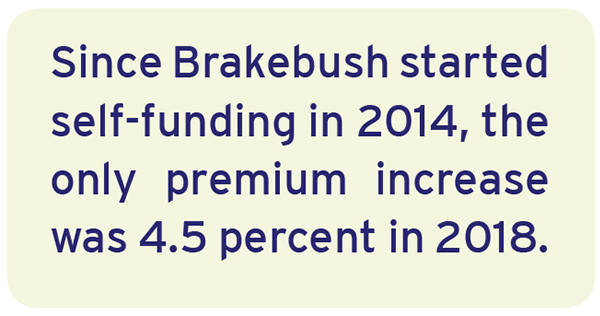Self-funding was the first step toward changing the health care cost curve at Brakebush Brothers Inc. in Westfield, WI. Brakebush Brothers started self-funding its employee health benefit plan in 2014.
In 2018, its health benefit costs were lower than in 2014, even when the cost to run its on-site Advanced Primary Care clinic was factored in.
During that same time period, employers nationwide saw average annual cost increases that varied from 3.9 percent in 2014 to 3.6 percent in 2018, according to the Mercer U.S. National Survey of Employer-Sponsored Health Plans.
Brakebush Brothers’ success is based on treating self-funding as the first of many steps toward high-value health care, according to Dan Ludwig, Director of Benefits and Safety. “After we became self-funded in 2014, we really worked that year to answer the question, ‘What can we do differently now?’” Ludwig said.
Access to Data
Self-funding’s differences include access to health benefits data, which is typically unavailable or limited to a few standard reports in a fully-insured plan.
“A key factor is to have access to the data and understand where you’ve got issues,” Ludwig said. “In comparison, the reporting you get from traditional plans is not great.” Self-funding’s data is only valuable, Ludwig said, if the plan sponsor is committed to make major changes to act on what it learns.
“You need the attitude that we’re going to attack this. You have to want to take action.” Brakebush assigned Ludwig, who was then the director of safety, health, and wellness, to create and direct new initiatives that would change health care costs. His occupational training helped him
quickly spot areas where changes would pay off.
“The reality is that the concepts are fairly similar: You look for problem areas and you try to knock them down,” Ludwig said. But health care problem-solving is complicated by privacy rules, which mean “you
can’t dive into who did what.”
Yet you can still identify patterns that contribute to higher costs. Brakebush used data analysis to create categories of spending that identified the “problem areas.”
Employer of Choice
Brakebush also knew it needed to remain the “employer of choice” in Westfield, population 1,250, and surrounding Marquette County, where the population totals roughly 15,300 people. Brakebush has 1,100 Wisconsin employees, plus another 900 employees at plants in Minnesota, North Carolina, and Texas.
Ludwig said Brakebush’s size means it has “maxed out” its ability to hire locally. Before self-funding, the company had used the traditional method of passing more costs to employees, but it knew that was unsustainable over time. While its workforce is loyal, employees will leave Brakebush if the company fails to offer competitive health and wellness benefits.
“It was getting to the point that employees were noticing that inexpensive health benefits were becoming more expensive every year,” Ludwig said. “We didn’t want to continue to have to pass these costs along.”
So Brakebush put together a package of services designed to save money while serving a wide range of health and wellness needs. Two steps were critical:
- Offering a Centers of Excellence Program to direct employees to providers for specialized services that range from surgery to sleep studies. Employees receive cash incentives for using the program’s providers. In 2017, Brakebush tallied savings of $378,000 from redirected care. In 2018, savings grew to $650,000.
- Opening an On-site Health Clinic to offer free primary and acute care medicine services for all employees and for spouses and dependents covered by a Brakebush health plan. (Brakebush does charge a fee for the members that choose the high deductible plan and have a health savings account, as required by federal regulation.) Patients made 2,000 visits to the on-site clinic for medical services in 2018. The clinic includes a physical therapy component for controlling musculoskeletal issues.
“Providing primary care certainly has an impact,” Ludwig notes. “Traditional primary care clinics are sometimes accused of being a system to feed larger and more expensive procedures to specialists. We don’t have to worry about that. We have an independent physician that runs it and has no vested interest in producing a certain number of MRIs or surgical procedures, for example.”

Since Brakebush started self-funding in 2014, the only premium increase was 4.5 percent in 2018.
A Health and Wellness Package
Brakebush also offers a package of services that support employee health and wellness, including:
On-site physical therapy (PT) provided by three physical therapists, including two who have Ph.Ds., add up to the equivalent of one full-time onsite therapist. They are supported by a full-time physical therapy assistant.
These on-site rehabilitation services alone saved the company more than $110,000 in 2018. They also conduct “comfort surveys” that identify employee needs on the production line, with special efforts made to engage employees who show signs of developing bigger health issues – whether it is due to an occupational exposure or a personal health issue. The PT program had 3,000 visits in 2018.
Brakebush’s workers’ compensation savings for soft tissue injuries is estimated at over $350,000 annually due to this on-site program.
Additional onsite medical services, including the primary and urgent care service, as well as monthly visits from an orthopedic surgeon, onsite mammograms through a mobile service, and access to at-home sleep studies.
International pharmacy services that use a mail-order service to import high-cost medicines from Canada at a cost that averages 75 percent below U.S. prices. Savings topped $120,000 in 2018 for the
35 members utilizing the program.
A well-rounded wellness program that includes physical fitness at an on-site fitness center but also addresses all components of health. Employees can meet with a personal trainer to identify personal fitness needs. When they return to the fitness center or log in from an outside computer, they will then receive a personalized fitness video for each workout session. These workouts can be tracked electronically and add up to roughly 300 workout hours per week. Other onsite wellness services include the opportunity to meet with local financial institutions to discuss financial needs; health coaching; hypnotism; free legal information from a local law firm; and an on-site chaplain.
Ludwig also believes it was critical to hire a healthcare coordinator to serve as a “point person” for employees or covered dependents who need a medical service. This position was later combined into the role of the corporate manager of benefits when the department restructured.
The position’s duties include working with employees using the Center of Excellence program from the time they decide they need a procedure until the service is completed and any qualified incentives are paid. The manager is also available to discuss options, incentives and costs with the member for any health care service.
Joining The Alliance
Joining a cooperative of employers who pool their purchasing power was another effective strategy. Brakebush joined The Alliance in 2015 for two reasons.
- An analysis of The Alliance provider networks showed that contracted rates with health care providers would result in significant savings over their existing network.
- The Alliance made it possible for Brakebush to collaborate with other employers on ways to control health care costs. The Alliance cooperative includes more than 300 employers who offer
self-funded health benefits in Wisconsin, Illinois and Iowa.
Ludwig said attending Events by The Alliance gives him both the latest health benefit information from regional or national experts and a chance to connect with peers at other companies.
Because The Alliance is a not-for-profit cooperative of employers who are committed to moving health care forward, Ludwig knows The Alliance’s incentives are aligned with his company’s best interests.

“The Alliance is way beyond a network, because the cooperative also gives us the ability to collaborate with others and gives us resources to control our health benefit costs,” Ludwig said. “You get to meet with people who have been there, done that and can share the solutions that worked for them and tell us about additional challenge points we need to be aware of.”
Ludwig takes the same approach in looking at other health benefit partners.
Brakebush Brothers’ Seven Tips for Self-Funding Success:
- Get ready to self-fund. Looking back, Ludwig thinks Brakebush should have had new solutions ready to introduce when self-funding started in 2014, so employees immediately noticed the difference.
- Be willing to change. Employers get the best results by combining self-funding with data-driven changes in their health plan.
- Develop a team of collaborators, internally and externally. Internally, create a team of employees who take responsibility for changing the health plan to focus on high-value health care. Externally, network with peers at other companies and then find vendor partners who are interested in working with you on innovative solutions. Your relationships will make a difference in what you achieve.
- Make sure partners have aligned incentives. They should “win” financially when your company wins and lose when it loses.
- Tell employees how self-funding makes a difference to their out-of-pocket costs. Explaining the relationship between the company’s costs and their health benefit premiums is a great place to start.
- Remind employees of ways to save, again and again. Sharing information at open enrollment is critical, but employees also need reminders throughout the year. If you have an onsite clinic, make sure clinic providers know all the current options for employees to use programs such as Centers of Excellence.
- Use employers’ combined power. Employers’ ability to change how they purchase health care grows when they work together.
Support From the Top
Ludwig praises open-minded executives at Brakebush for their support for changing the company’s approach to health benefit costs.
“Employers have to get rid of the status quo,” Ludwig said. “That means employers can’t do it the way they’ve always done it. At Brakebush, we’re given the freedom to explore opportunities. We have to justify every one of these changes, but we’re given the ability to go and explore.”
Ludwig believes that only companies who realize health care can be controlled will be able to achieve flat or lower benefit costs. Employers who are unwilling to challenge the status quo, learn about health care pricing or embrace innovative approaches are unlikely to gain the full benefits of self-funding.
“The lack of understanding in the world of how health care is paid and what impact it has on business has really led us to this problem,” Ludwig said.
“Employers have to look at health care and say, ‘We’re done with this.’ “As employers, we control everything else that is on our budget and we hold vendors accountable for giving us high-value products and services. Why are we not holding health care to the same standards?”
